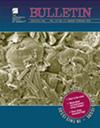Differentiation and convection in a magma chamber: Novel insights on the origin of mafic microgranular enclaves in the Tongkeng pluton, Xiaojiang area, SE China
IF 3.7
1区 地球科学
Q1 GEOSCIENCES, MULTIDISCIPLINARY
引用次数: 0
Abstract
Mafic microgranular enclaves (MMEs), commonly found in granitoid intrusions, can provide unique perspectives on the nature of magma sources and evolution, physicochemical properties of magmas, and geotectonic dynamic evolution. However, their origin and generation remain under debate. In this paper, the Cretaceous Tongkeng pluton with MME occurrence located in the Xiaojiang area of Zhejiang Province, SE China, was examined. Zircon U-Pb dating indicates that the gabbroic diorite, MMEs, and their host quartz diorite all crystallized at 107−106 Ma. All samples from the Tongkeng pluton show a comparable range of initial 87Sr/86Sr values (0.70746−0.70841), εNd(t) values (−4.9 to −2.9), and zircon εHf(t) values (−7.3 to −2.9) with the peak value of −6 to −4. In addition, Pb isotope compositions are fairly consistent. Petrology, geochemical and isotopic compositions, and geochemical modeling suggest that the gabbroic diorite, MMEs, and their host rock were cognate and their primary magma was derived from the mixing between a mantle-derived magma and a crustal magma. The “magma differentiation and convection” model, proposed in this paper to improve our understanding of the origin of the MMEs and their host rock, suggests that the gabbroic and quartz dioritic magmas were formed by cognate magma differentiation, and the MME magma is a portion of the gabbroic dioritic magma that is incorporated into and mingled with the quartz dioritic magma. Misjudgment in the origin and generation of MMEs leads to an erroneous understanding of mantle properties, the genesis of granitoids, and therefore, many other geological processes. Hence, caution is needed when considering the relationship between the host granitoid and its associated MMEs with similar chemical and isotopic compositions, particularly for those exposed in areas where mafic rocks are absent (or undiscovered).岩浆腔中的分异和对流:对中国东南部小江地区汤坑岩浆岩微晶飞地成因的新认识
常见于花岗岩侵入体中的岩浆微晶粒飞地(MMEs)可以为研究岩浆来源和演化的性质、岩浆的物理化学性质以及大地构造的动态演化提供独特的视角。然而,它们的起源和生成仍存在争议。本文研究了位于中国东南部浙江省萧江地区的白垩纪铜坑岩浆岩。锆石U-Pb年代测定结果表明,辉长闪长岩、MMEs及其母岩石英闪长岩均在107-106 Ma时结晶。来自汤坑岩体的所有样品都显示出相似的 87Sr/86Sr 初始值(0.70746-0.70841)、εNd(t) 值(-4.9--2.9)和锆石εHf(t) 值(-7.3--2.9)范围,峰值为-6--4。此外,铅同位素组成也相当一致。岩石学、地球化学和同位素组成以及地球化学模型表明,辉长闪长岩、MMEs 及其母岩是同源的,它们的原生岩浆来自地幔岩浆和地壳岩浆的混合。本文提出的 "岩浆分异与对流 "模型,旨在加深我们对MMEs及其母岩成因的认识,该模型认为辉长岩和石英闪长岩岩浆是由同源岩浆分异形成的,MMEs岩浆是辉长闪长岩岩浆的一部分,融入石英闪长岩岩浆并与之混合。对 MME 的起源和生成的错误判断会导致对地幔性质、花岗岩的成因以及许多其他地质过程的错误理解。因此,在考虑主花岗岩与其具有相似化学成分和同位素成分的相关岩浆岩之间的关系时,需要谨慎从事,特别是那些暴露在没有(或未发现)岩浆岩地区的岩浆岩。
本文章由计算机程序翻译,如有差异,请以英文原文为准。
求助全文
约1分钟内获得全文
求助全文
来源期刊

Geological Society of America Bulletin
地学-地球科学综合
CiteScore
9.30
自引率
8.20%
发文量
159
审稿时长
4-8 weeks
期刊介绍:
The GSA Bulletin is the Society''s premier scholarly journal, published continuously since 1890. Its first editor was William John (WJ) McGee, who was responsible for establishing much of its original style and format. Fully refereed, each bimonthly issue includes 16-20 papers focusing on the most definitive, timely, and classic-style research in all earth-science disciplines. The Bulletin welcomes most contributions that are data-rich, mature studies of broad interest (i.e., of interest to more than one sub-discipline of earth science) and of lasting, archival quality. These include (but are not limited to) studies related to tectonics, structural geology, geochemistry, geophysics, hydrogeology, marine geology, paleoclimatology, planetary geology, quaternary geology/geomorphology, sedimentary geology, stratigraphy, and volcanology. The journal is committed to further developing both the scope of its content and its international profile so that it publishes the most current earth science research that will be of wide interest to geoscientists.
 求助内容:
求助内容: 应助结果提醒方式:
应助结果提醒方式:


